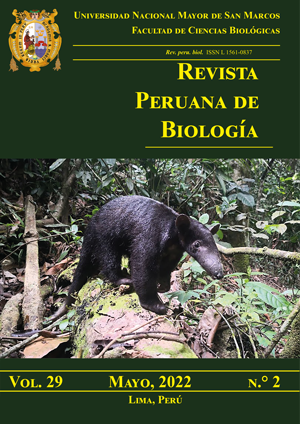Record of melanism in Tamandua tetradactyla (Pilosa: Myrmecophagidae) in Perú
DOI:
https://doi.org/10.15381/rpb.v29i2.22106Keywords:
Melanism, Myrmecophagidae, Tamandua tetradactyla, Huanuco, PerúAbstract
A case of melanism in Tamandua tetradactyla (Myrmecophagidae) is recorded, based on an individual observed in the Huánuco Department, Peru. Two previous records are found in the iNaturalist database. With this record, the number of melanistic mammal species in Peru increases to four. It should be noted that cases of melanism in this species have already been reported in the Neotropics.
Downloads
References
Barros P, Ledesma A, Moreira L. 2014. Firsts records of melanistic genet (Genetta genetta L., 1758) in North Portugal. Anales de Biología,
Caro T. 2005. The adaptive significance of coloration in mammals. BioScience, 55(2), 125-136. https://doi.org/https://doi.org/10.1641/0006-3568(2005)055[0125:TASOCI]2.0.CO;2
Chandramohan B, Renieri C, La Manna V, La Terza A. 2013. The alpaca agouti gene: genomic locus, transcripts and causative mutations of eumelanic and pheomelanic coat color. Gene, 521(2), 303-310. https://doi.org/10.1016/j.gene.2013.03.060
Gardner A L. 2008. Mammals of South America, volume 1: marsupials, xenarthrans, shrews, and bats (Vol. 2). Chicago: University of Chicago Press.
Hayssen V. 2011. Tamandua tetradactyla (Pilosa: Myrmecophagidae). Mammalian Species, 43(875), 64-74. https://doi.org/https://doi.org/10.1644/875.1
Hubbard JK, Uy JAC, Hauber ME, Hoekstra HE, Safran RJ. 2010. Vertebrate pigmentation: from underlying genes to adaptive function. Trends in Genetics, 26(5), 231-239. https://doi.org/https://doi.org/10.1016/j.tig.2010.02.002
Konter A. 2015. Aberrant plumages in grebes Podicipedidae: An analysis of albinism, leucism, brown and other aberrations in all grebe species worldwide. Ferrantia 72, Musée national d’histoire naturelle, Luxembourg, 206 p.
Majerus ME. 1998. Melanism. Evolution in action. Oxford University Press
Medina YK, Medina CE. 2019. Primer registro de melanismo en Phyllotis limatus (Rodentia: Cricetidae), con una lista actualizada de mamíferos silvestres melánicos del mundo. Revista peruana de biología, 26(4), 509-520. https://doi.org/10.15381/rpb.v26i4.14967
Millien V, Kathleen Lyons S, Olson L, Smith FA, Wilson AB, Yom-Tov Y. 2006. Ecotypic variation in the context of global climate change: revisiting the rules. Ecol Lett, 9(7), 853-869. https://doi.org/10.1111/j.1461-0248.2006.00928.x
Montgomery G. 1985. Impact of vermilinguas (Cyclopes, Tamandua: Xenarthra = Edentata) on arboreal ant populations. En: Montgomery GG. (ed.), The Evolution and Ecology of Armadillos, Sloths, and Vermilinguas. Washington, DC.: Smithsonian Institution Press, pp. 351–363
Nedyalkov N, Koshev Y, Raykov I, Bardarov G. 2014. Color variation of small mammals’s (Mammalia: Rodentia and Insectivora) coats from Bulgaria. North-western journal of zoology, 10(2), 314-317.
Pacheco V, Diaz S, Graham-Angeles L, Flores-Quispe M, Calizaya-Mamani G, Ruelas D, Sánchez-Vendizú P. 2021. Lista actualizada de la diversidad de los mamíferos del Perú y una propuesta para su actualización. Revista peruana de biología, 28(4), e21019. https://doi.org/10.15381/rpb.v28i4.21019
Rengifo EM, Scullion J, Cueto LE, Huaytalla V. 2019. A new case of melanic jaguar, Panthera onca (carnivora: felidae) from Peru. Folia Amazónica, 28(2), 249-254.
Ríos-Alvear G, Cadena-Ortiz H. 2019. Records of melanistic Tamandua tetradactyla (Pilosa, Myrmecophagidae) from Ecuador. Neotropical Biology and Conservation, 14, 339. https://doi.org/10.3897/neotropical.14.e37714
Rodríguez E. 2016. Informe temático: CLIMA. Mesozonificación ecológica y económica para el desarrollo sostenible zona de selva del Departamento de Huánuco. Iquitos: IIAP – DEVIDA.
Rosa CA da, Hobus Q, Bager A. 2010. Mammalia, Pilosa, Myrmecophagidae, Tamandua tetradactyla (Linnaeus, 1758): distribution extension. Check List. 6(1):52–53. https://doi.org/10.15560/6.1.052
Silva LG da. 2017. Ecology and Evolution of Melanism in Big Cats: Case Study with Black Leopards and Jaguars. [place unknown]: IntechOpen. https://doi.org/10.5772/intechopen.69558
Silva L G da. 2014. Análise da distribuição espacial do melanismo na família Felidae em função de condicionantes ambientais. 183 f. Tese (Doutorado em Zoologia) - Pontifícia Universidade Católica do Rio Grande do Sul, Porto Alegre. https://tede2.pucrs.br/tede2/handle/tede/271
Smith P, Elsam R. 2007. [online] Southern Tamandua, Tamandua tetradactyla - FAUNA Paraguay Handbook of the Mammals of Paraguay Volume 2. Mammals of Paraguay Nº 3. [http://www.faunaparaguay.com/mamm3Tamanduatetradactyla.pdf]
Superina M, Miranda F, Plese T. 2008. Maintenance of Xenarthra in captivity. In: Vizcaíno SF, Loughry WJ. (eds.). The biology of the Xenarthra. Gainesville: University Press of Florida. 232-243p.
Tello C, Streicker DG, Gomez J, Velazco PM. 2014. New records of pigmentation disorders in molossid and phyllostomid (Chiroptera) bats from Peru. Mammalia. 78(2):191–197. https://doi.org/10.1515/mammalia-2013-0019
van Grouw H. 2006. Not every white bird is an albino: sense and nonsense about colour aberrations in birds. Dutch Birding, 28(2), 79-89.
Wetzel RM. 1985. The identification and distribution of recent Xenarthra (= Edentata). In: Montgomery GG, (ed.).The evolution and ecology of armadillos, sloths, and vermilinguas. Washington, DC: Smithsonian Institution Press. 5-21p.
Downloads
Published
Issue
Section
License
Copyright (c) 2022 Alejandro Portillo, Stefanía Sibille, Nadia Panaifo

This work is licensed under a Creative Commons Attribution 4.0 International License.
AUTHORS RETAIN THEIR RIGHTS:
a. Authors retain their trade mark rights and patent, and also on any process or procedure described in the article.
b. Authors retain their right to share, copy, distribute, perform and publicly communicate their article (eg, to place their article in an institutional repository or publish it in a book), with an acknowledgment of its initial publication in the Revista Peruana de Biologia.
c. Authors retain theirs right to make a subsequent publication of their work, to use the article or any part thereof (eg a compilation of his papers, lecture notes, thesis, or a book), always indicating its initial publication in the Revista Peruana de Biologia (the originator of the work, journal, volume, number and date).






